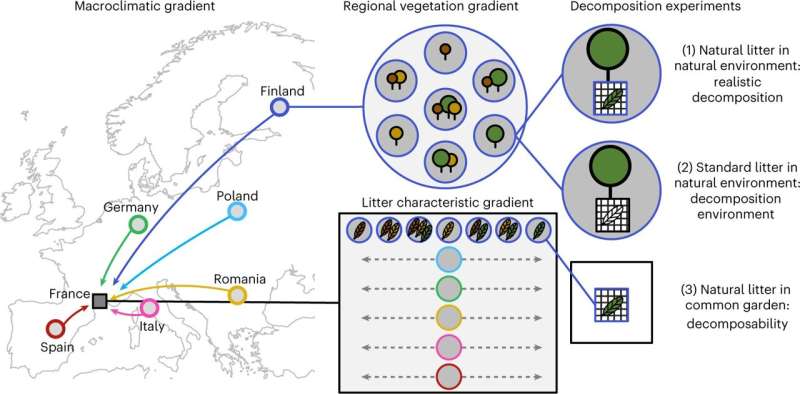This article has been reviewed according to Science X's editorial process and policies. Editors have highlighted the following attributes while ensuring the content's credibility:
fact-checked
peer-reviewed publication
trusted source
proofread
Climate key to determining dead plant decomposition and predicting carbon emissions

A new study from the University of Stirling, published in Nature Ecology & Evolution, has found that climate is the dominant driver in determining how quickly dead plants decompose, allowing scientists to make more accurate predictions about carbon emissions and climate change globally.
Decaying dead plants and leaves, known as plant litter, release 60 petagrams of carbon into the atmosphere every year—six times more than all human emissions—and contribute around 10% of the total amount of carbon in the atmosphere.
Although these emissions are natural and key to functional ecosystems, any increase in their rate could further accelerate climate change. Knowing about the conditions in which dead plants decompose more or less quickly has crucial impacts on predicting and understanding CO2 concentrations and fluctuations in the Earth's atmosphere.
Lecturer in Soil Ecology at the University of Stirling, Dr. François-Xavier Joly, carried out the research at France's University of Montpellier. He said, "This research is important as it refines our understanding of one of the most important fluxes of carbon to the atmosphere and suggests that we may have been studying decomposition incorrectly in recent years.
"The carbon emitted to the atmosphere through decomposition accelerates climate change, so this improved understanding is vital to helping better predict future carbon emissions and climate scenarios in our changing world. Our specific findings might also help modelers to put more realistic parameters into their systems, and provide more accurate future climate predictions as a result.
"The more accurately we can predict how the natural process of dead plant material decomposition is responding to the ongoing climate change crisis, the better we can understand how its response may slow down or accelerate climate change in the years to come."
The research paper, "Resolving the intricate role of climate in litter decomposition," settles a recent debate about whether small-scale environmental conditions or large-scale differences in climate are the most influential force for controlling decomposition rates. It found differences in climate across regions ultimately has a far greater impact on the rate of decomposition, upholding the legitimacy and effectiveness of using carbon flux models, which simulate future climate change scenarios based on regions' climates.
The research team studied around 200 varying forest plots from six regions across Europe, from Spain to Finland, where they collected climatic, canopy, soil and litter quality data. Academics placed artificial plant litter like sheets of paper and sticks of wood to decompose in plots alongside the natural litter from the surrounding environment, for example, dead oak tree leaves in an oak tree forest, and measured their rate of decomposition over a year.
While the artificial plant litter, commonly used in studies of this kind, suggested a stronger control of small-scale environmental conditions on decomposition, the decomposition of the natural, so-called plant litter was largely controlled by large-scale climatic conditions.
More information: François-Xavier Joly et al, Resolving the intricate role of climate in litter decomposition, Nature Ecology & Evolution (2023). DOI: 10.1038/s41559-022-01948-z
Journal information: Nature Ecology & Evolution
Provided by University of Stirling





















